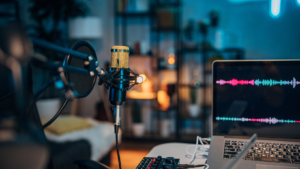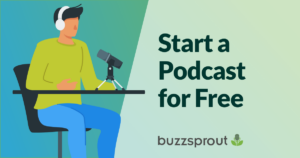Feeling overwhelmed over starting a podcast? Not sure how to start one? Fret not, newbies! While it is not as difficult as you make it out to be, nece
Feeling overwhelmed over starting a podcast? Not sure how to start one? Fret not, newbies! While it is not as difficult as you make it out to be, necessary steps will need to be taken to launch your podcast episodes. To boost your confidence in setting up your early podcast career, let us discuss the basic steps of how to start a podcast season and what processes and tools you will need for its eventual creation.
 The Selection Phase
The Selection Phase
You should have a precise topic in mind before starting a podcast. Guide questions such as “Who is this podcast for?”, ” Why am I the right person to make it?” and “What is the goal of my podcast?” will help you think through a podcast idea.
It should be a unique and compelling topic you find interesting or something as simple as a subject you care about. Be it something you are passionate about or expertise in a particular field of interest. You can narrow it down to the specifics and then expand from there as you attain more popularity.
The most important thing to remember is that it is entirely up to you to appeal to the right audience you have made your podcast for.
Development of Podcast Concept
Suppose you have already listened to and reviewed several podcast episodes. In that case, you might already have quite a grasp on its varying format (which is highly dependent on the chosen topic).
Choose what format best suits your podcast episode and get creative from there. Some may be conversational or interview-based which necessitates the presence of a guest. While others may focus on a narrative format such as storytelling. However, with co-hosting, keep in mind that setting schedules will be challenging. Therefore, you will need to plan ahead of time.
Additionally, you should ponder the podcast duration and publishing frequency, which should be consistent. In our article “How To Record A Podcast,” the optimal podcast length is 20-40 minutes. And the podcast publishing schedule should be once a week to establish a consistent and steady connection with listeners as discuss in “What’s The Best Schedule For A Podcast Growth.”

Perfecting your way through from start to finish
To attract and keep your audience hooked, a compelling introduction may just do the trick. Having intro music or sound effects will make your podcast episode more polished, further captivating more listeners. It also expresses the brand’s personality while setting the show’s vibe and tune. To add, it is crucial to have an engaging synopsis while remaining ambiguous to capture your target audience’s attention.
With a solution in mind to solve a particular issue, tell your audience why it will vastly benefit them to stick around as you remedy the concern narratively. The introduction should appear as a teaser of the episode without spoiling away the entire content of your show.
Furthermore, a good host introduction and tagline will provide familiarization among listeners who come across your profile, acquainting them with your content and niche.
Set up your Setup: Tools, software, equipment, and more!
Podcast equipment is expensive and is one of the main reasons why most starters struggle to establish a career in podcasting. It is not necessary to get your hands on the latest technology and gadget to produce high-quality content. Since seasoned podcasters can make do with the most basic setup, so can you!
Let us take a look at what instruments you should have in your working station to get started.
 Mic and Connection
Mic and Connection
These microphones are known best for podcasting; you just need to choose the mic that best suits your style.
Dynamic microphones have lesser sensitivity with the capacity to pick up lower frequencies. Due to this, background noises will be one less thing to worry about. On the other hand, the condenser has more sensitivity which can pick up a wider range of frequencies. Levels of its sensitivity are ideal in recording music compared to spoken words.
Furthermore, you can choose between the two types of connection of podcast mics; XLR or USB. Although the XLR usually has a long life with maximum flexibility, it will require an interface or mixer and therefore is considered an expensive option for beginners. On the other hand, USB mics are cheaper and can be plugged into your computer. It is the usual choice for most podcasters due to its reasonable price.
 Remote Podcast Software
Remote Podcast Software
Whether it may be for long-distance recordings for a collaborative show or wanting better audio quality, software for remote recording has been developed to do the job with less hassle. There are Riverside.fm, Squadcast, and Zoom with a monthly subscription ranging from free to $15, which will significantly help with recording the show remotely, whether it may be for an episode.

 Editing Software
Editing Software
Once you have finished recording, it is time to edit. GarageBand is already pre-installed for most Apple computers, free and beginner-friendly. Another option that is free of charge is Audacity, an open-source audio editor with pro-level features that is slightly difficult to navigate through in comparison.
On the other hand, Descript is a $10/month multipurpose software that allows recording, transcribing, mixing, and editing audio files. It can remove filler words automatically and dub over a phrase with text-to-speech cloning.
Additionally, Hindenburg Pro is designed specifically for podcasters and journalists alike. It is a $12/month pro-level editing software with simple tools for spoken words and automated options to streamline your workflow.
Tips for Successfully Launching Your Podcast Season: Ready To Launch?
We have covered the basics of podcast tips for you to get started. What is left is for you to begin your podcasting career as soon as possible! It is vital to bear in mind that a great podcast starts with appropriate planning, creative content, consistency, and commitment. Remember that keeping your listeners engaged is foundational to successful podcasting!


COMMENTS